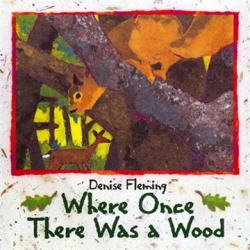- Home
- Tutorial
- Resource Guides
- Focus Areas
- LSF Programs
-
Professional
Development - Review Process
-
A project of LSF

Search for Resources
Description
This uniquely illustrated picture book explores the abundance of creatures that once inhabited a natural area before its conversion to a housing development. The text is suited for young readers but the concepts are appropriate for more advanced learners as well. Illustrations and text effectively convey the change in mood that occurs as the vibrant and beautiful natural setting becomes rigid and uninspiring due to development.
Click here for more information regarding the author's books, school visits, or teaching resources.
General Assessment
Recommendation of how and where to use it
This book is a perfect way to incorporate ESD concepts into larger units of study on habitats, communities and issues in sustainability. Students may also be encouraged to explore the natural spaces around their homes or the school playground to determine the number of species that rely on the space. Teachers may choose to incorporate the art techniques of this picture book into integrated lessons.
Relevant Curriculum Units
The following tool will allow you to explore the relevant curriculum matches for this resource. To start, select a province listed below.
- Step 1Select a province
- Alberta
- Step 2Select a grade level
- Grade 1
- Step 3Select a subject
- Science
- Step 4Relevant matches
- Living Systems: Understandings of the living world, Earth, and space are deepened by investigating natural systems and their interactions.
- Grade 2
- Step 3Select a subject
- Science
- Step 4Relevant matches
- Living Systems: Understandings of the living world, Earth, and space are deepened by investigating natural systems and their interactions
- Grade 3
- Step 3Select a subject
- Science
- Step 4Relevant matches
- Living Systems: Understandings of the living world, Earth, and space are deepened through investigating natural systems and their interactions
- British Columbia
- Step 2Select a grade level
- Grade 1
- Step 3Select a subject
- Science
- Step 4Relevant matches
- Science 1: Living things have features and behaviours that help them survive in their environment
- Grade 2
- Step 3Select a subject
- Science
- Step 4Relevant matches
- Science 2: Living things have life cycles adapted to their environment
- Grade 3
- Step 3Select a subject
- Science
- Step 4Relevant matches
- Science 3: Living things are diverse, can be grouped, and interact in their ecosystems
- Manitoba
- Newfoundland & Labrador
- Northwest Territories
- Step 2Select a grade level
- Grade 1
- Step 3Select a subject
- Science
- Step 4Relevant matches
- Life Systems: Characteristics and Needs of Living Things
- Science 1: Plants and animals have features and behaviours that help them survive in their environment
- Grade 2
- Step 3Select a subject
- Science
- Step 4Relevant matches
- Life Science: Growth and Changes in Animals
- Science 2: Plants and animals have life cycles adapted to their environment
- Grade 3
- Step 3Select a subject
- Science
- Step 4Relevant matches
- Science 3:Plants and Animals are diverse, can be grouped, and interact in their ecosystems
- Nova Scotia
- Nunavut
- Ontario
- Step 2Select a grade level
- Kindergarten
- Step 3Select a subject
- Science & Technology
- Step 4Relevant matches
- Problem Solving and Innovating: Overall Expectations
- Grade 1
- Step 3Select a subject
- Science & Technology
- Step 4Relevant matches
- Life Systems: Needs and Characteristics of Living Things
- Grade 2
- Step 3Select a subject
- Science & Technology
- Step 4Relevant matches
- Life Systems: Growth & Changes in Animals
- Prince Edward Island
- Quebec
- Step 2Select a grade level
- Grade 1
- Step 3Select a subject
- Science & Technology
- Step 4Relevant matches
- Living things
- Grade 2
- Step 3Select a subject
- Science & Technology
- Step 4Relevant matches
- Living things
- Saskatchewan
- Yukon Territory
- Step 2Select a grade level
- Grade 1
- Step 3Select a subject
- Science
- Step 4Relevant matches
- Science 1: Living things have features and behaviours that help them survive in their environment
- Grade 2
- Step 3Select a subject
- Science
- Step 4Relevant matches
- Science 2: Living things have life cycles adapted to their environment
- Grade 3
- Step 3Select a subject
- Science
- Step 4Relevant matches
- Science 3: Living things are diverse, can be grouped, and interact in their ecosystems
Themes Addressed
Ecosystems (5)
- Appreciating the Natural World
- Endangered Species
- Habitat Loss
- Interdependence
- Wildlife Protection
Land Use & Natural Resources (1)
- Forests

